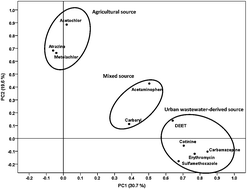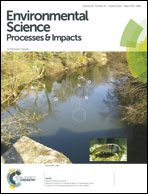Identifying sources of emerging organic contaminants in a mixed use watershed using principal components analysis†
Abstract
Principal components analysis (PCA) was used to identify sources of emerging organic contaminants in the Zumbro River watershed in Southeastern Minnesota. Two main principal components (PCs) were identified, which together explained more than 50% of the variance in the data. Principal Component 1 (PC1) was attributed to urban wastewater-derived sources, including municipal wastewater and residential septic tank effluents, while Principal Component 2 (PC2) was attributed to agricultural sources. The variances of the concentrations of cotinine, DEET and the prescription drugs carbamazepine, erythromycin and sulfamethoxazole were best explained by PC1, while the variances of the concentrations of the agricultural pesticides atrazine, metolachlor and acetochlor were best explained by PC2. Mixed use compounds carbaryl, iprodione and daidzein did not specifically group with either PC1 or PC2. Furthermore, despite the fact that caffeine and acetaminophen have been historically associated with human use, they could not be attributed to a single dominant land use category (e.g., urban/residential or agricultural). Contributions from septic systems did not clarify the source for these two compounds, suggesting that additional sources, such as runoff from biosolid-amended soils, may exist. Based on these results, PCA may be a useful way to broadly categorize the sources of new and previously uncharacterized emerging contaminants or may help to clarify transport pathways in a given area. Acetaminophen and caffeine were not ideal markers for urban/residential contamination sources in the study area and may need to be reconsidered as such in other areas as well.


 Please wait while we load your content...
Please wait while we load your content...